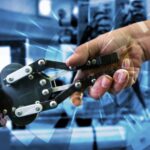Technology has evolved at an exponential pace over the past seven decades, revolutionizing the way we live, work, and communicate. From the invention of the transistor to the rise of the Internet and mobile computing, each decade has been marked by groundbreaking developments that have pushed the boundaries of what is possible. In this article, we will explore the key milestones that have shaped the evolution of technology over the past seven decades and examine how these advancements have led to the interconnected and innovative world we live in today.
The birth of the transistor and the information age
The dawn of the information age was marked by the invention of the transistor in 1947 at Bell Labs. This revolutionary new electronic component replaced bulky and inefficient vacuum tubes, ushering in an era of miniaturization in electronics. The transistor’s ability to amplify and switch electronic signals made it the cornerstone of modern digital technology.
The impact of the transistor cannot be overstated. It paved the way for the development of smaller, more powerful, and more efficient electronic devices, leading to a surge of innovation across various industries. Radios, televisions, and computers became more accessible and affordable, transforming the way people communicated, accessed information, and conducted business.
The transistor’s impact extended beyond consumer electronics. It fueled advancements in fields such as space exploration, medicine, and industrial automation. Its compact size and low power consumption made it ideal for applications where weight and energy efficiency were critical, such as satellites, pacemakers, and robots.
The invention of the transistor marked a pivotal moment in human history. It laid the foundation for the digital revolution, shaping the world we live in today. From smartphones to supercomputers, the transistor’s influence can be seen in countless technologies that have become integral to our daily lives. Its enduring legacy as one of the most important technological breakthroughs of the 20th century continues to inspire and drive innovation in the 21st century and beyond.
The space race and the rise of supercomputing
During the 1960s, the Space Race between the United States and the Soviet Union became a driving force behind the rapid advancement of supercomputing. These incredibly powerful machines were indispensable for conducting complex calculations crucial to the success of space missions, such as analyzing trajectories and determining orbital mechanics. The development of supercomputers not only revolutionized space exploration but also had a profound impact on various scientific disciplines, including weather forecasting and climate modeling.
As technology marched forward in the 1970s and 1980s, supercomputers underwent a remarkable transformation, becoming increasingly sophisticated and accessible. This accessibility democratized scientific research and engineering, empowering scientists and engineers to tackle intricate problems that were previously considered computationally intractable. The introduction of supercomputers opened up new vistas of scientific discovery and technological innovation, ushering in an era of unprecedented progress.
With supercomputers at their disposal, scientists and engineers were able to delve into previously uncharted territories of knowledge. Complex simulations became feasible, enabling researchers to gain deeper insights into natural phenomena and engineering challenges. Supercomputers revolutionized disciplines as diverse as materials science, fluid dynamics, and drug design, leading to breakthroughs that improved our understanding of the world and enhanced technological capabilities.
Furthermore, the advent of supercomputers had a transformative impact on society beyond scientific research. These powerful machines became essential tools in various industries, including finance, manufacturing, and entertainment. The ability to process massive amounts of data and perform complex calculations in a matter of seconds revolutionized decision-making processes and optimized operational efficiencies across a wide range of sectors.
The personal computer revolution and the dawn of the Internet
The 1970s bore witness to the advent of the first personal computers, heralding a transformative era in the realms of work, education, and communication. In 1975, the Altair 8800 emerged as a pioneering personal computer, followed by the Apple II in 1977 and the IBM PC in 1981. These early personal computers, while expensive and challenging to operate, laid the groundwork for the widespread accessibility of personal computers in the years to come.
A pivotal moment in the democratization of personal computers occurred in 1984 when Apple introduced the Macintosh, the first mass-market personal computer equipped with a graphical user interface (GUI). The Macintosh achieved remarkable commercial success, propelling the adoption of personal computers in households and professional settings alike.
The year 1989 witnessed another groundbreaking innovation with the invention of the World Wide Web (WWW) by Tim Berners-Lee. This invention laid the foundation for the Internet, revolutionizing the way individuals communicate and share information across the globe. The Internet has since become an integral part of our daily lives, reshaping communication, entertainment, commerce, and education.
The era of mobile computing and the Internet of Things
It is a period of rapid technological change that has had a profound impact on the way people live and work. The proliferation of smartphones, tablets, and other mobile devices has made it possible for people to access information and communicate with others from anywhere in the world. This has led to a significant increase in productivity and flexibility, as people are no longer tied to their desks in order to get work done.
In addition to the convenience and flexibility that mobile devices offer, they have also made it possible for people to stay connected with friends and family members who live far away. Social media platforms such as Facebook, Twitter, and Instagram have made it easy for people to share photos, videos, and updates about their lives with others, regardless of their location. This has helped to create a more connected and globalized society.
The Internet of Things (IoT) is another key technology that is shaping the era of mobile computing. IoT refers to the network of physical devices that are embedded with sensors, software, and other technologies that allow them to connect and exchange data with other devices and systems over the Internet. This technology has the potential to revolutionize many aspects of our lives, from the way we manage our homes to the way we travel.
For example, IoT devices can be used to automate tasks such as turning on the lights when we come home or adjusting the thermostat when we leave. They can also be used to track our fitness activity, monitor our health, and even keep an eye on our homes while we’re away. As IoT technology continues to develop, we can expect to see even more innovative and groundbreaking applications for this technology in the years to come.
The era of mobile computing and the Internet of Things is still in its early stages, but it is already having a major impact on our lives. As these technologies continue to develop, we can expect to see even more profound changes in the way we live and work in the years to come.
Conclusion
The remarkable evolution of technology over the past seven decades has transformed every facet of our lives. From the invention of the transistor, the cornerstone of modern digital technology, to the rise of the Internet and mobile computing, each decade has witnessed groundbreaking developments that have propelled us into a new era of connectivity and innovation. The journey from bulky vacuum tubes to supercomputers and personal computers has revolutionized the way we work, learn, and communicate.
The Internet has connected the world, enabling instant access to information and communication, while mobile computing has made it possible to stay connected from anywhere. Social media platforms have fostered global communities, and the Internet of Things promises to revolutionize how we manage our lives. As we look to the future, emerging technologies such as artificial intelligence, quantum computing, and biotechnology hold immense potential to shape the course of human progress for generations to come.
Individuals, organizations, and societies must adapt and embrace these changes to harness their full potential. Continuous learning, skill development, and innovation will be key to navigating the ever-evolving technological landscape. By adopting the transformative power of technology, we can create a future that enhances human capabilities, fosters inclusivity, and drives sustainable progress for the betterment of humanity.










